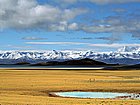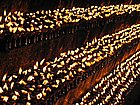西藏手冊(81):拉薩(2)-大昭寺之一
西藏手冊(81):拉薩(2)-大昭寺之一
PLACES OF INTEREST IN CENTRAL LHASA
Jokhang Temple
--------------
During the reign of Songtsen Gampo's father, the king of the
Kathmandu valley was one of Amshuvarman, who instated his own era in
576 (he was preceded by Shivadeva and followed by the latter's son
Udayadeva in 621, and thereafter by the usurper Jisnugupta/Visnugupta
in 624). Udayadeva's son Narendradeva fled to Lhasa when his father
was overthrown, and remained there until his return from exile,
probable with Tibetan assistance, and enthronement in 641, after
which he introduced the Matsyendranath cult. He is said to have
vanished into the foot of Kathmandu's celebrated Matsyendranath image
at the time of his death.
It was during Narendradeva's sojourn in Lhasa that Songtsen Gampo
married the Nepalese princess Bhrikuti, who arrived in Lhasa in 632
or 634 and began construction of the Potala. Later, he married the
Chinese princess Wengcheng who arrived in Lhasa in 641 and remained
there until her death in 680/681. In consequence of this latter
marriage, the Tang emperor Kao Tsung bestowed upon Songtsen Gampo
the title Baowang, 'jewel king'.
Geomantic importance of the Jokhang
The Jokhang is Tibet's most sacred shrine, the focal point of
polgrims from the entire Tibetan plateau. Situated at the heart of
the old town of Lhasa, it was founded by Queen Bhrikuti, on a site
deemed by Queen Wengcheng to be the principal geomantic power-place
in Tibet, identified with the heart of the supine ogress. To
facilitate the contruction of the Jokhang, in 638 the Othang Lake
had been filled in with earth, trasported by goats. The original
name of the town Rasa ('place of the goat') was subsequently altered
to Lhasa ('place of the deity') following the temple's consecration.
However, further obstacles had to be eliminated by the construction
of 12 outlying geomantic temples before the building of this central
temple could be completed. In this way, the Jokhang came to form the
centre of a grand geomantic scheme whereby temples were erected in
three successive rings of four on the body of the 'supine ogress'
which is Tibet (ie on her shoulders and hips, elbows and knees, and
hands and feet). On the Jokhang's eventual completion (647), the
temple was known as Rasa Trulnang ('magical apparition of Rasa');
and also as Gazhi Trulnang ('magical apparition endowed with four
joys') because its construction was said to have brought happiness
to the four classes of the populace.
The main gate of the Jokhang temple faces W towards Nepal in
recognition of Queen Bhrikuti who bore the expense of the Jokhang's
construction. The original desing appears to have had a Newar model,
and only later was it said to have been modelled on Vikramashila
Monastery in NW India. The earliest phase of building, traces of
which indicate distinctive Newar influence, are to be seen in the
original door-frames of the four ground-floor inner chapels dedicated
to Mahakarunika, Amitabha, Shakyamuni, and Maitreya; and those of
the second storey at the centre of the destroyed N wing, and the
Zhalre Lhakhang of the E wing, as well as the Songtsen Chapel of the
W wing. The fact that the Newar queen wished to make the third storey
but never did may indicate their premature death. Later, when the
third storey was added, the temple was said to represent the three
buddhabodies (Trikaya) or three world-systems (Tridhatu).
Bhrikuti installed the primary images in a pentoid arrangement
(5 main chapels flanked by vihara-like cells) within a square hall;
the deity Aksobhya in the centre flanked by Amitabha and Maitreya;
with Mahakarunika and Shakyamuni Acalavajra on the N and S wings
respectively. There were four gates: one in each of the four walls,
and 37 columns represented the 37 sections of the Vinaya.
Songtsen Gampo erected the protector shines, with images of naga
kings, Ravana and Kubera to safeguard the temple from the elements.
He also concealed this treasures (terma) in important pillars of the
Jokhang; a custom perhaps linked to the age-old Tibetan tradition of
concealing wealth at the foundation of buildings or pillars.
Renovations
The Jokhang has undergone continuous renovation since its original
establishment. The main phases of renovation may be attributed to the
following:
a) Queen Jincheng refurbished the temple, King Senalek Jinyon cleared
the outer courtyard, and King Relpachen built the Meru and Karu
temples to the rear; while adding certain minor images.
b) Atisha discovered Songtsen Gampo's testament, the Kachem Khakolma,
in the Jokhang; while Zangkar Lotsawa Phakpa Sherab enlarged the
central chapel and altered the Zhelre Lhakhang.
c) Dakpo Gompa Tsultrim Nyingpo (1116-69) renovated the other chapels,
including the Zhalre Lhakhang murals of the second storey and built
the inner circuit (nangkhor).
d) Gade Zangpo and Monlam Dorje of Tsel Gungtang (14th century)
renovated the first 2 storeys of the present great hall
(area 25,084 sq m).
e) Phakdru Drakpa Gyeltsen built the front extension or Outer Jokhang
in 1409.
f) Desi Sangye Gyatso and Dalai Lama VI added further halls,
replacing the old tiled roof with a golden roof.
g) The Mongol Ta Lama of Sera added the rooftop emblem of the
dharma-wheel flanked by two deer in 1927.
h) Following the damage of the Cultural Revolution, 1/3 of the
complex was restored between 1972 and 1975. Presently the site is
2,600 sq m in area with 121 statues. The temple was reopened in
1979 with nine monks.
i) The most recent and extensive renovations were carried out
between 1992 and 1994.
Layout
The Inner Jokhang in 3 storeys forms a square (82.5 sq m),
enclosing the inner hall known as Kyilkhor Thil. This structure
is surrounded by the inner circumambulation pathway (nangkhor),
beyond which is the 2-storeyed Outer Jokhang or western extension,
containing secondary chapels, storerooms, kitchens, toilets and
residential quarters. The Meru Nyingba temple adjoins the Jokhang
on the E side, while the S and W sides are adjoined by other
buildings. This whole structure is surrounded by the intermediate
circumambulation pathway (barkhor); which in turn is surrounded by
the old city of Lhasa, with the Potala beyond. The outer walkway
(linkhor) on which pilgrims even now circumambulate the entire holy
city of Lhasa forms an outer ring-road, and much of it has been
encorporated into the modern road infrastructure of the city.
Outer Jokhang
--------------
In the square in front of the entrance, the Jokhang plaza, formerly
known after its flagpole, the Juya Darchen there is the stump of a
willow reputedly planted by Princess Wengcheng. It is flanked by two
more recent willows and enclosed within a new stone wall. In front of
the stump is the pock-marked obelisk of 1794 admonishing against
smallpox, and another inscriptionless stele. In an adjacent enclosure
to the N is the 6m obelisk with an inscription commemorating the
Sino-Tibetan peace treaty of 821/822.
The entrance portico (Khyamra Gochor) with six fluted columns is
fronted by a courtyard (dochal) where pilgrims prostrate and have
worn the flagstones smooth. Side-murals depict the Four Guardian
Kings and the Four Harmonious Brethren. The structure is surmounted
by a balcony hidden by a yak-hair curtain, from which dignitaries
would observe ceremonies conducted below. The upper N wing of the
Outer Jokhang contains the Labrangteng; from which successive Dalai
Lamas would observe important ceremonies. It has a grand reception
hall; while below are storerooms, and the Sitar Courtyard, where
living animals would be ransomed from the slaughterhouse as an act
of merit. The S wing of the Outer Jokhang contains the offices of
the Panchen Lamas (formerly those of the Tibean cabinet).
Gyalchen Zhi Lhakhang (Zimgo Chinang Nyiwar)
Entering from the left and after passing two large prayer wheels,
the pilgrim first sees statues of the Four Guardian Kings backed by
17th and 19th century frescoes of gandharvas and nagas, and flanked
by those of Samantabhadra's paradise. This ante-chamber leads through
the inner door.
Kyamra Chenmo (Main Courtyard)
Within the main assembly hall, the 19th century murals on the W wall
depict Gushri Qan, Dalai Lama V and Panchen Lama IV; and the Thousand
Buddhas of the Aeon. The murals of the S wall depict the founding of
the three large monasteries around Lhasa, and the life of the the
Buddha. The W murals above the entrance depict the nine aspects of
Amitayus, and the meditational deities Guhyasamaja, Cakrasamvara,
and Bhairava, as well as Kalacakra.
The hall (32m by 39m) was constructed by Tsonkhapa for the Great
Prayer Festival in 1409. It is in the form of an open atrium, with
large murals along its cloistered walls (dating from 1648). On the N
side is the 2-storeyed residence of the Dalai Lama, with its gilded
roof and window overlooking the courtyard. The rooftop view from this
outer hall overlooks the elaborate western facade.
Along the N wall are, in succession:
1) The Namthar Gosum Lhakhang, with images of the Buddhas of the
Three Times, the Eight Bodhisattvas, and the two gatekeepers. A
staircase leads down from the Dalai Lama's private quarters.
2) Shugtri Chenmo, the Dalai Lama's stone throne, backed by paintings
of Shakyamuni, Avalokiteshvara and Manjushri, with the Thousand
Buddhas;
3) Dolma Lhakhang, containing an image of Cintamani Tara flanked by
White and Green Tara, and backed on the left and right respectively
by images of Nyaknyon Sewa Rinchen (who sculpted the original
Cintamani image) and Atisha. Its rear (W) wall has images of the
Twenty-one Taras in two tiers, originally commissioned by
Dalai Lama VII, with Shantaraksita, Padmasambhava and Trisong Detsen
forming a trio on the N side, along with Tsongkhapa and his foremost
students. A long stone altar stands in front of the inner gateway.
Outside the door is a stone bearing a handprint of Longdol Lama.
4) Embedded within the NW column at the entrance to the inner
circumambulation pathway are two stones, said to have been thrown
there by Tsangnyon Heruka Sangye Gyeltsen and Unyon Kunga Zangpo.
5) The Inner Circumambulation (nangkhor) is lined with prayer-wheels
and murals outlined in gold on red back-ground, which depict the
Thousand Buddhas and scenes from the Avadanakalpalata, interspersed
with stupas and relief-images. On the N side are four successive
chapels entered from the westernmost one, namely: Tamdrin Sangdrubling
(with images of Hayagriva and Kurukulla), Mahakarunika,
Sarvaidvairocana, and the innermost dedicated to the Eight Medicine
Buddhas. On the E side are: Neten chudruk Lhakhang, with contains
images commissioned by Desi Sangye Gyatso; the Gurubum Lhakhang
(containing 100,000 images of Padmasambhava surrounding three central
images), and the Sera Dago, which is a gate connecting the Jokhang
with Meru Nyingba temple and the Dago Rung-khang kitchen (used during
the Great Prayer Festival by the monks of Sera). On the S side,
outside the wall, is the Sung Chora debating courtyard, renovated in
1986, and containing a yellow stone platform where thrones (shugtri)
for Tsongkhapa, the Dalai Lama, and the Ganden Tripa were set up
during the Great Prayer Festival, and where the annual Geshe
examinations were held. Also, outside the wall on this S side are the
temples dedicated to the Eight Medicine Buddhas, the Sixteen Elders,
the Graduated Path (lamrim), and the Eight Sugatas; and a 3-storey
Ngakhang, or tantric college, offering an excellent rooftop view of
the Jokhang.
During the Great Prayer Festival, the monks of the three main
monasteries would be seated in the assembly hall - those from Sera
in the N, Drepung in the centre, and Ganden in the S. The Dalai Lama
would be flanked by Shartse Choje and Jangtse Choje, the hierarchs of
the two colleges of Ganden monastery, and the entire ceremony would
be supervised by the Ganden Tripon (head of the Gelukpa school), and
the Tsokchen Umdze from Drepung.
TIBET HANDBOOK
Gyurme Dorje
Trade & Travel Publications Ltd. January 1996
ISBN 0 900571 69 X
PLACES OF INTEREST IN CENTRAL LHASA
Jokhang Temple
--------------
During the reign of Songtsen Gampo's father, the king of the
Kathmandu valley was one of Amshuvarman, who instated his own era in
576 (he was preceded by Shivadeva and followed by the latter's son
Udayadeva in 621, and thereafter by the usurper Jisnugupta/Visnugupta
in 624). Udayadeva's son Narendradeva fled to Lhasa when his father
was overthrown, and remained there until his return from exile,
probable with Tibetan assistance, and enthronement in 641, after
which he introduced the Matsyendranath cult. He is said to have
vanished into the foot of Kathmandu's celebrated Matsyendranath image
at the time of his death.
It was during Narendradeva's sojourn in Lhasa that Songtsen Gampo
married the Nepalese princess Bhrikuti, who arrived in Lhasa in 632
or 634 and began construction of the Potala. Later, he married the
Chinese princess Wengcheng who arrived in Lhasa in 641 and remained
there until her death in 680/681. In consequence of this latter
marriage, the Tang emperor Kao Tsung bestowed upon Songtsen Gampo
the title Baowang, 'jewel king'.
Geomantic importance of the Jokhang
The Jokhang is Tibet's most sacred shrine, the focal point of
polgrims from the entire Tibetan plateau. Situated at the heart of
the old town of Lhasa, it was founded by Queen Bhrikuti, on a site
deemed by Queen Wengcheng to be the principal geomantic power-place
in Tibet, identified with the heart of the supine ogress. To
facilitate the contruction of the Jokhang, in 638 the Othang Lake
had been filled in with earth, trasported by goats. The original
name of the town Rasa ('place of the goat') was subsequently altered
to Lhasa ('place of the deity') following the temple's consecration.
However, further obstacles had to be eliminated by the construction
of 12 outlying geomantic temples before the building of this central
temple could be completed. In this way, the Jokhang came to form the
centre of a grand geomantic scheme whereby temples were erected in
three successive rings of four on the body of the 'supine ogress'
which is Tibet (ie on her shoulders and hips, elbows and knees, and
hands and feet). On the Jokhang's eventual completion (647), the
temple was known as Rasa Trulnang ('magical apparition of Rasa');
and also as Gazhi Trulnang ('magical apparition endowed with four
joys') because its construction was said to have brought happiness
to the four classes of the populace.
The main gate of the Jokhang temple faces W towards Nepal in
recognition of Queen Bhrikuti who bore the expense of the Jokhang's
construction. The original desing appears to have had a Newar model,
and only later was it said to have been modelled on Vikramashila
Monastery in NW India. The earliest phase of building, traces of
which indicate distinctive Newar influence, are to be seen in the
original door-frames of the four ground-floor inner chapels dedicated
to Mahakarunika, Amitabha, Shakyamuni, and Maitreya; and those of
the second storey at the centre of the destroyed N wing, and the
Zhalre Lhakhang of the E wing, as well as the Songtsen Chapel of the
W wing. The fact that the Newar queen wished to make the third storey
but never did may indicate their premature death. Later, when the
third storey was added, the temple was said to represent the three
buddhabodies (Trikaya) or three world-systems (Tridhatu).
Bhrikuti installed the primary images in a pentoid arrangement
(5 main chapels flanked by vihara-like cells) within a square hall;
the deity Aksobhya in the centre flanked by Amitabha and Maitreya;
with Mahakarunika and Shakyamuni Acalavajra on the N and S wings
respectively. There were four gates: one in each of the four walls,
and 37 columns represented the 37 sections of the Vinaya.
Songtsen Gampo erected the protector shines, with images of naga
kings, Ravana and Kubera to safeguard the temple from the elements.
He also concealed this treasures (terma) in important pillars of the
Jokhang; a custom perhaps linked to the age-old Tibetan tradition of
concealing wealth at the foundation of buildings or pillars.
Renovations
The Jokhang has undergone continuous renovation since its original
establishment. The main phases of renovation may be attributed to the
following:
a) Queen Jincheng refurbished the temple, King Senalek Jinyon cleared
the outer courtyard, and King Relpachen built the Meru and Karu
temples to the rear; while adding certain minor images.
b) Atisha discovered Songtsen Gampo's testament, the Kachem Khakolma,
in the Jokhang; while Zangkar Lotsawa Phakpa Sherab enlarged the
central chapel and altered the Zhelre Lhakhang.
c) Dakpo Gompa Tsultrim Nyingpo (1116-69) renovated the other chapels,
including the Zhalre Lhakhang murals of the second storey and built
the inner circuit (nangkhor).
d) Gade Zangpo and Monlam Dorje of Tsel Gungtang (14th century)
renovated the first 2 storeys of the present great hall
(area 25,084 sq m).
e) Phakdru Drakpa Gyeltsen built the front extension or Outer Jokhang
in 1409.
f) Desi Sangye Gyatso and Dalai Lama VI added further halls,
replacing the old tiled roof with a golden roof.
g) The Mongol Ta Lama of Sera added the rooftop emblem of the
dharma-wheel flanked by two deer in 1927.
h) Following the damage of the Cultural Revolution, 1/3 of the
complex was restored between 1972 and 1975. Presently the site is
2,600 sq m in area with 121 statues. The temple was reopened in
1979 with nine monks.
i) The most recent and extensive renovations were carried out
between 1992 and 1994.
Layout
The Inner Jokhang in 3 storeys forms a square (82.5 sq m),
enclosing the inner hall known as Kyilkhor Thil. This structure
is surrounded by the inner circumambulation pathway (nangkhor),
beyond which is the 2-storeyed Outer Jokhang or western extension,
containing secondary chapels, storerooms, kitchens, toilets and
residential quarters. The Meru Nyingba temple adjoins the Jokhang
on the E side, while the S and W sides are adjoined by other
buildings. This whole structure is surrounded by the intermediate
circumambulation pathway (barkhor); which in turn is surrounded by
the old city of Lhasa, with the Potala beyond. The outer walkway
(linkhor) on which pilgrims even now circumambulate the entire holy
city of Lhasa forms an outer ring-road, and much of it has been
encorporated into the modern road infrastructure of the city.
Outer Jokhang
--------------
In the square in front of the entrance, the Jokhang plaza, formerly
known after its flagpole, the Juya Darchen there is the stump of a
willow reputedly planted by Princess Wengcheng. It is flanked by two
more recent willows and enclosed within a new stone wall. In front of
the stump is the pock-marked obelisk of 1794 admonishing against
smallpox, and another inscriptionless stele. In an adjacent enclosure
to the N is the 6m obelisk with an inscription commemorating the
Sino-Tibetan peace treaty of 821/822.
The entrance portico (Khyamra Gochor) with six fluted columns is
fronted by a courtyard (dochal) where pilgrims prostrate and have
worn the flagstones smooth. Side-murals depict the Four Guardian
Kings and the Four Harmonious Brethren. The structure is surmounted
by a balcony hidden by a yak-hair curtain, from which dignitaries
would observe ceremonies conducted below. The upper N wing of the
Outer Jokhang contains the Labrangteng; from which successive Dalai
Lamas would observe important ceremonies. It has a grand reception
hall; while below are storerooms, and the Sitar Courtyard, where
living animals would be ransomed from the slaughterhouse as an act
of merit. The S wing of the Outer Jokhang contains the offices of
the Panchen Lamas (formerly those of the Tibean cabinet).
Gyalchen Zhi Lhakhang (Zimgo Chinang Nyiwar)
Entering from the left and after passing two large prayer wheels,
the pilgrim first sees statues of the Four Guardian Kings backed by
17th and 19th century frescoes of gandharvas and nagas, and flanked
by those of Samantabhadra's paradise. This ante-chamber leads through
the inner door.
Kyamra Chenmo (Main Courtyard)
Within the main assembly hall, the 19th century murals on the W wall
depict Gushri Qan, Dalai Lama V and Panchen Lama IV; and the Thousand
Buddhas of the Aeon. The murals of the S wall depict the founding of
the three large monasteries around Lhasa, and the life of the the
Buddha. The W murals above the entrance depict the nine aspects of
Amitayus, and the meditational deities Guhyasamaja, Cakrasamvara,
and Bhairava, as well as Kalacakra.
The hall (32m by 39m) was constructed by Tsonkhapa for the Great
Prayer Festival in 1409. It is in the form of an open atrium, with
large murals along its cloistered walls (dating from 1648). On the N
side is the 2-storeyed residence of the Dalai Lama, with its gilded
roof and window overlooking the courtyard. The rooftop view from this
outer hall overlooks the elaborate western facade.
Along the N wall are, in succession:
1) The Namthar Gosum Lhakhang, with images of the Buddhas of the
Three Times, the Eight Bodhisattvas, and the two gatekeepers. A
staircase leads down from the Dalai Lama's private quarters.
2) Shugtri Chenmo, the Dalai Lama's stone throne, backed by paintings
of Shakyamuni, Avalokiteshvara and Manjushri, with the Thousand
Buddhas;
3) Dolma Lhakhang, containing an image of Cintamani Tara flanked by
White and Green Tara, and backed on the left and right respectively
by images of Nyaknyon Sewa Rinchen (who sculpted the original
Cintamani image) and Atisha. Its rear (W) wall has images of the
Twenty-one Taras in two tiers, originally commissioned by
Dalai Lama VII, with Shantaraksita, Padmasambhava and Trisong Detsen
forming a trio on the N side, along with Tsongkhapa and his foremost
students. A long stone altar stands in front of the inner gateway.
Outside the door is a stone bearing a handprint of Longdol Lama.
4) Embedded within the NW column at the entrance to the inner
circumambulation pathway are two stones, said to have been thrown
there by Tsangnyon Heruka Sangye Gyeltsen and Unyon Kunga Zangpo.
5) The Inner Circumambulation (nangkhor) is lined with prayer-wheels
and murals outlined in gold on red back-ground, which depict the
Thousand Buddhas and scenes from the Avadanakalpalata, interspersed
with stupas and relief-images. On the N side are four successive
chapels entered from the westernmost one, namely: Tamdrin Sangdrubling
(with images of Hayagriva and Kurukulla), Mahakarunika,
Sarvaidvairocana, and the innermost dedicated to the Eight Medicine
Buddhas. On the E side are: Neten chudruk Lhakhang, with contains
images commissioned by Desi Sangye Gyatso; the Gurubum Lhakhang
(containing 100,000 images of Padmasambhava surrounding three central
images), and the Sera Dago, which is a gate connecting the Jokhang
with Meru Nyingba temple and the Dago Rung-khang kitchen (used during
the Great Prayer Festival by the monks of Sera). On the S side,
outside the wall, is the Sung Chora debating courtyard, renovated in
1986, and containing a yellow stone platform where thrones (shugtri)
for Tsongkhapa, the Dalai Lama, and the Ganden Tripa were set up
during the Great Prayer Festival, and where the annual Geshe
examinations were held. Also, outside the wall on this S side are the
temples dedicated to the Eight Medicine Buddhas, the Sixteen Elders,
the Graduated Path (lamrim), and the Eight Sugatas; and a 3-storey
Ngakhang, or tantric college, offering an excellent rooftop view of
the Jokhang.
During the Great Prayer Festival, the monks of the three main
monasteries would be seated in the assembly hall - those from Sera
in the N, Drepung in the centre, and Ganden in the S. The Dalai Lama
would be flanked by Shartse Choje and Jangtse Choje, the hierarchs of
the two colleges of Ganden monastery, and the entire ceremony would
be supervised by the Ganden Tripon (head of the Gelukpa school), and
the Tsokchen Umdze from Drepung.
TIBET HANDBOOK
Gyurme Dorje
Trade & Travel Publications Ltd. January 1996
ISBN 0 900571 69 X
 MITS 美景國際旅行社
MITS 美景國際旅行社MEIJING INTERNATIONAL TRAVEL SERVICE LTD
專門為台灣/香港/澳門等世界各地華人、外國人(外籍遊客)提供特色西藏、青海、
尼泊爾、四川等地度假觀光旅行服務,為您量身定制個性旅行計劃(獨立成團、小
包團、自由行、團體旅遊、散客拼團,另提供各類朝聖、徒步登山探險等特種旅遊)
外籍遊客進藏旅行須知:辦理台灣遊客入藏批准函.旅行證件.外國人去西藏旅行手續
Sponsored Links
特別聲明:
A:關於美景旅遊網獨立原創文章圖片等內容
1、美景旅遊網原創文章、圖片版權由我們全部保留;
2、美景旅遊網原創文章、圖片任何網站及媒體均可以免費使用,如轉載我們的文章或圖片,
請註明來自美景旅遊網 並鏈接到 www.mjjq.com,商業用途請先聯繫我們;
3、免責:我們在我們能知悉的範圍內努力保證所有采寫文章的真實性和正確性,但不對真實性和正確性做任何保證。本站采寫文章圖片如果和事實有所出入,美景旅遊網不承擔連帶責任;
B:關於美景旅遊網採用非原創文章圖片等內容
1、頁面的文章、圖片等等資料的版權歸版權所有人所有。
2、免責:由於採集的圖片、文章內容來源於互聯網,內容頁面標注的作者、出處和原版權者一致性無法確認,如果您是文章、圖片等資料的版權所有人,請與我們聯繫,我們會及時加上版權信息,如果您反對我們的使用,本著對版權人尊重的原則,我們會立即刪除有版權問題的文章或圖片內容。
3、本頁面發表、轉載的文章及圖片僅代表作者本人觀點。
A:關於美景旅遊網獨立原創文章圖片等內容
1、美景旅遊網原創文章、圖片版權由我們全部保留;
2、美景旅遊網原創文章、圖片任何網站及媒體均可以免費使用,如轉載我們的文章或圖片,
請註明來自美景旅遊網 並鏈接到 www.mjjq.com,商業用途請先聯繫我們;
3、免責:我們在我們能知悉的範圍內努力保證所有采寫文章的真實性和正確性,但不對真實性和正確性做任何保證。本站采寫文章圖片如果和事實有所出入,美景旅遊網不承擔連帶責任;
B:關於美景旅遊網採用非原創文章圖片等內容
1、頁面的文章、圖片等等資料的版權歸版權所有人所有。
2、免責:由於採集的圖片、文章內容來源於互聯網,內容頁面標注的作者、出處和原版權者一致性無法確認,如果您是文章、圖片等資料的版權所有人,請與我們聯繫,我們會及時加上版權信息,如果您反對我們的使用,本著對版權人尊重的原則,我們會立即刪除有版權問題的文章或圖片內容。
3、本頁面發表、轉載的文章及圖片僅代表作者本人觀點。
西藏旅遊
Tibet Travel
西藏旅遊目的地 
走進神秘西藏
西藏風光圖庫
熱門點擊 
最新旅遊報價










